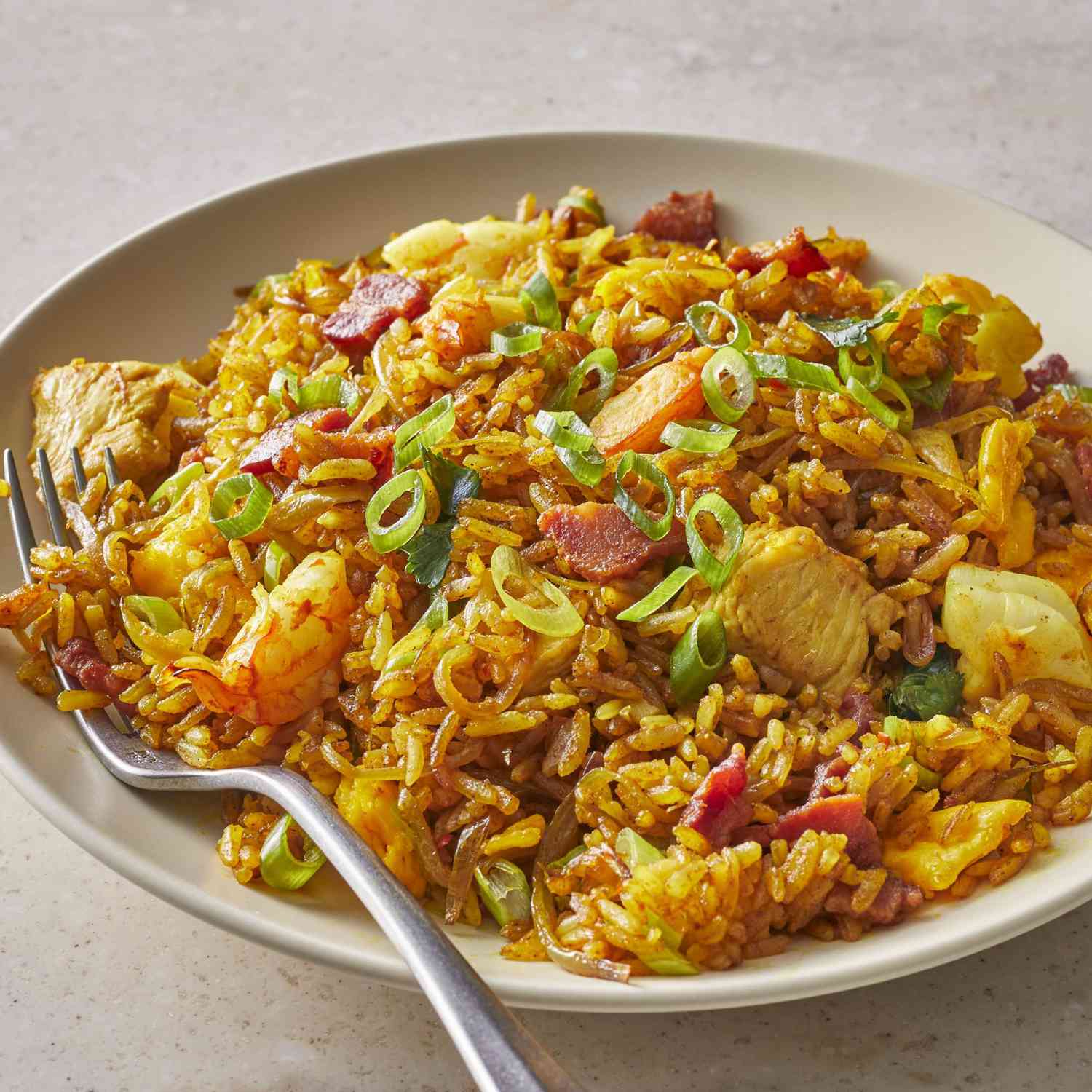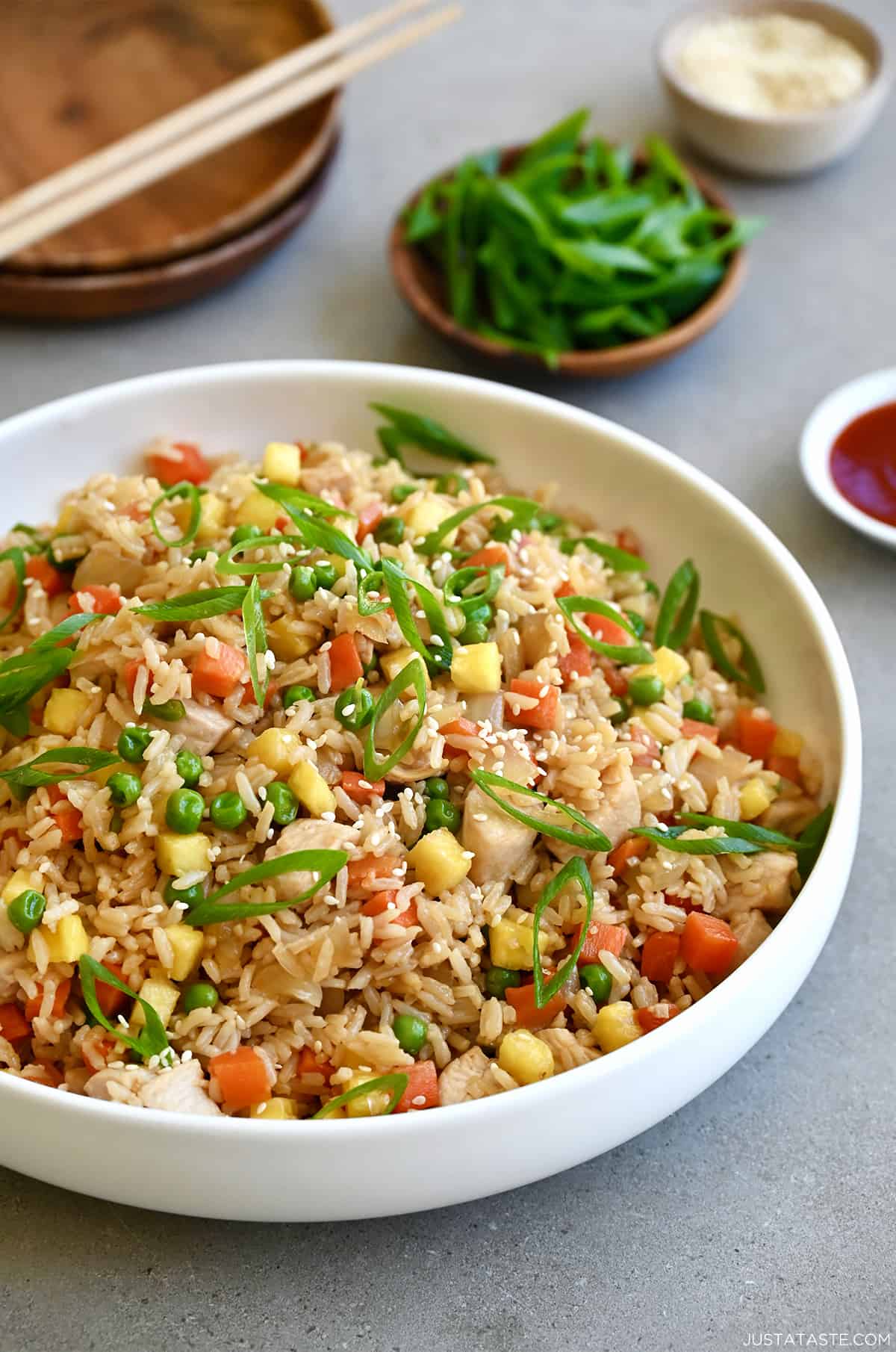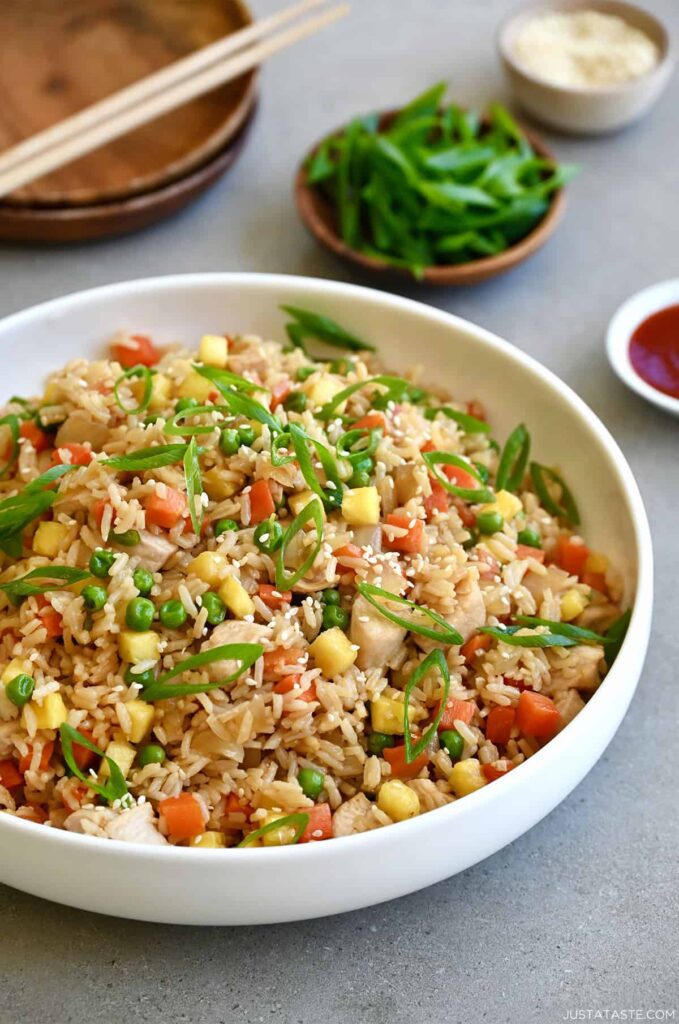Pineapple Chicken and Rice is a delicious recipe that combines amazing flavors and textures.
Pineapple Chicken and Rice offers a perfect balance of sweet, savory, and tangy flavors that transport your taste buds to tropical paradise while providing a complete, satisfying meal. The combination of tender chicken, vibrant vegetables, and sweet pineapple in a glossy, flavorful sauce served over fluffy rice creates a harmony of textures and tastes that appeals to both adults and children alike. This dish exemplifies how simple ingredients can be transformed into something extraordinary through careful balancing of flavors and proper cooking technique.
What sets this preparation apart is the way the pineapple serves multiple roles—it provides natural sweetness, acidity to tenderize the chicken, and beautiful visual appeal. The sauce, thickened with cornstarch, clings perfectly to each piece of chicken and vegetable, ensuring every bite is packed with flavor. The quick cooking method preserves the bright colors and crisp-tender texture of the vegetables while keeping the chicken juicy. This recipe demonstrates how stir-frying, when done properly, can create dishes that are both healthy and deeply satisfying.
The Science of Stir-Frying
Stir-frying is a cooking technique that applies high heat for a short time, preserving texture, color, and nutrients. The Maillard reaction—the chemical reaction between amino acids and reducing sugars—occurs quickly at high temperatures, creating complex flavors and appealing browning on the chicken. The cornstarch in the marinade not only tenderizes the chicken but also helps create a protective coating that prevents moisture loss during cooking.

The pineapple contains bromelain, an enzyme that breaks down proteins, naturally tenderizing the chicken. However, this enzyme is deactivated by heat, which is why fresh pineapple is used in the final minutes of cooking rather than earlier. The acidity of the pineapple also helps balance the richness of the dish while enhancing other flavors.
Ingredient Selection Guide
Chicken: Chicken thighs are ideal for stir-fries as they remain juicy even when cooked to higher temperatures. Their higher fat content adds flavor and prevents drying out. If using breast meat, reduce cooking time slightly to prevent toughness.
Pineapple: Fresh pineapple offers the best flavor and texture, but canned works well when drained properly. If using canned, choose pineapple in juice rather than syrup to control sweetness. Reserve the juice for the sauce.

Rice: Jasmine or basmati rice works beautifully with this dish, providing fragrance that complements the tropical flavors. Cook the rice with a bit less water than usual for slightly firmer grains that stand up to the sauce.
Soy Sauce: Use regular soy sauce for authentic flavor, but reduce sodium soy sauce works well too. For gluten-free versions, use tamari or coconut aminos. The soy sauce provides umami that balances the sweetness of the pineapple.
Technique Mastery
Marinating: The brief marination tenderizes the chicken and adds flavor. The cornstarch creates a velveting effect—a Chinese technique that gives restaurant-style texture to the meat. Don’t marinate too long or the texture can become mushy.

High Heat Cooking: Ensure your pan is properly heated before adding ingredients. The chicken should sizzle immediately upon contact. Cook in batches if necessary to avoid overcrowding, which causes steaming rather than browning.
Sauce Thickening: Stir the cornstarch slurry well right before adding to the pan. Add it to the center of the pan where it’s hottest, stirring constantly until it thickens. Once thickened, don’t continue cooking too long or the sauce may break.
Vegetable Timing: Add vegetables according to their cooking times—onions and bell peppers first as they take longer, then quicker-cooking ingredients like pineapple. This ensures everything is perfectly cooked without becoming mushy.

Flavor Variations
Spicy Version: Add 1-2 teaspoons of sriracha or red pepper flakes to the sauce for heat. Garnish with sliced fresh chili peppers for extra kick and visual appeal.
Thai-Inspired: Add 1 tablespoon of fish sauce and 1 teaspoon of lime zest to the sauce. Garnish with fresh cilantro and basil for Southeast Asian flavors.
Teriyaki Style: Increase the brown sugar to 1/4 cup and add 1 tablespoon of mirin to the sauce for a sweeter, more traditional teriyaki profile.
Vegetarian Version: Substitute firm tofu or tempeh for the chicken. Press the tofu well to remove excess water before marinating. Add edamame for additional protein.
Meal Prep Strategies
This dish is perfect for meal prepping. Cook a large batch of rice at the beginning of the week. The chicken can be marinated and stored in the refrigerator for up to 24 hours. The vegetables can be pre-cut and stored in airtight containers.
Leftovers keep well for 3-4 days in the refrigerator. Reheat gently in a skillet or microwave, adding a splash of water or pineapple juice to refresh the sauce. The flavors often improve after a day as they meld together.
For freezing, store without rice as the texture of thawed rice can be unpleasant. The chicken and vegetable mixture freezes well for up to 3 months. Thaw in the refrigerator overnight before reheating.
Serving Suggestions
Serve this dish in shallow bowls to showcase the colorful components. Garnish with additional green onions, sesame seeds, and maybe a lime wedge for squeezing over top. The bright colors make for appealing presentation.
For a complete meal, serve with a simple cucumber salad or steamed broccoli. The freshness of raw vegetables provides nice contrast to the rich stir-fry. A light soup like miso or hot and sour would also complement well.
Nutritional Considerations
This dish offers a good balance of protein, carbohydrates, and vegetables. For a lighter version, reduce the oil by half and use cooking spray for the pan. Increase the vegetable content and decrease the rice portion for lower carbohydrate intake.
For lower sodium versions, use reduced-sodium soy sauce and limit additional salt. The pineapple provides natural sweetness that allows for reducing added sugar. Using brown rice instead of white increases fiber content.
Cultural Context
While pineapple is native to South America, its incorporation into Asian-style dishes reflects the fusion cuisine that developed as ingredients traveled across cultures. The sweet-savory combination is characteristic of many Asian cuisines, particularly Chinese and Thai.
The specific combination of pineapple and chicken appears in various forms across different culinary traditions, from Hawaiian huli huli chicken to Thai pineapple fried rice. This recipe represents a Westernized version that incorporates elements from these various influences.
Final Thoughts
Pineapple Chicken and Rice represents the ideal weeknight meal—quick to prepare, nutritionally balanced, family-friendly, and bursting with flavor. The tropical notes provide a welcome escape from ordinary dinners, while the familiar format ensures broad appeal. Mastering this dish provides a template that can be adapted with different proteins, vegetables, and sauces, making it a valuable addition to any home cook’s repertoire. Whether cooking for a busy family dinner or meal prepping for the week ahead, this dish delivers satisfaction on multiple levels.

Pineapple Chicken and Rice
Ingredients
Method
- Cut chicken into bite-sized pieces.
- Combine with soy sauce, cornstarch, ginger, and garlic.
- Let marinate for at least 15 minutes while preparing other ingredients.
- Whisk together pineapple juice, soy sauce, brown sugar, rice vinegar, cornstarch, ginger, and garlic.
- Set aside until ready to use.
- Heat 1 tbsp oil in a large skillet or wok over high heat.
- Add chicken in a single layer and cook until browned and cooked through, about 5-7 minutes.
- Remove chicken from skillet and set aside.
- Add remaining oil to skillet.
- Add onion and bell pepper. Stir-fry for 2-3 minutes until slightly softened.
- Add pineapple chunks and cook for another 2 minutes.
- Return chicken to skillet with vegetables.
- Give sauce a quick stir and pour over chicken and vegetables.
- Cook, stirring constantly, until sauce thickens, about 2-3 minutes.
- Serve over cooked rice, garnished with green onions and sesame seeds.



